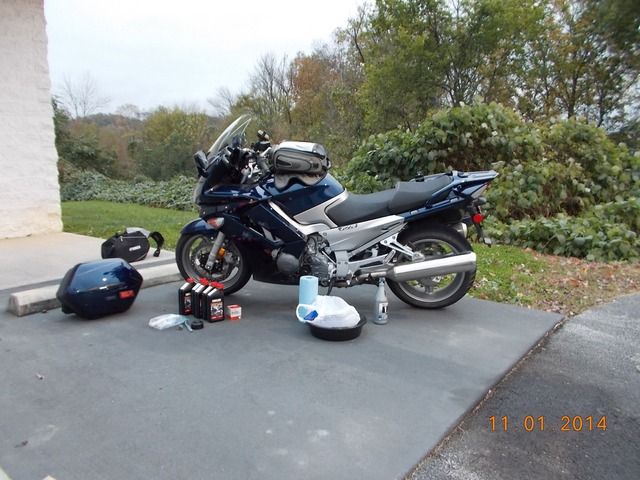TomInPA
Well-known member
Walmart in Norwalk Ohio. Trip from Sacramento, to Ocean City MD via great roads. Oil change before heading to the U.P. of Michigan.





I normally use Mobil 1 15W-50, but I figured I'd use Yamalube until switching to synthetic at 5000 miles. I found that it's a tight fit getting 5 quarts of oil, a filter, and some tools into one side case. Luckily I was travelling light and my clothing and toiletry kit fit into the other side case.
I may just do that. I have the same bike. If your clutch isn't slipping, it's a fair bet mine won't either.Ain't no other.
Try it, you'll like it.

FYI: Mobile 1 has been used in FJRs since they hit the US shores. They trick it to avoid anything with friction modifiers. That means no lower viscosity and especially nothing marked 0w[something]. The friction modifiers can lead to clutch slip. 15w50 is close to what Yamaha recommends (outside of the various Mobile 1 Moto oils).
The 15W is actually right in the middle of their recommendation. If 15Wxx is OK and xxW50 is good, then 15W50 is fine.Engine oil Lubrication system: Wet sumpRecommended brand: YAMALUBE
Type: SAE 10W-40, 10W-50, 15W-40, 20W-40 or 20W-50
Recommended engine oil grade: API service SG type or higher, JASO standard MA
Lots of oil goodness there ^^^The main problem with conventional multi-viscosity oils is the "viscosity improver" additives that are required to obtain that viscosity/temperature stability. I know that this is counter-intuitive, but an oil that has a larger spread between the first and second number actually maintains its viscosity better when heated than an oil with a smaller spread. Those VI additives are not as robust as the base oil and they will break down and shear in the transmission over time and then you end up with a much lower viscosity oil than what you started out with.
Typically, synthetic oils achieve their spread in multi-viscosity via the synthesis process, not by using VI additives, so they are not as prone to thinning, or shearing (in the transmission) over higher mileages, hence their ability to be used with increased change intervals..
"Energy Conserving" oils come in all different ranges of viscosity ratings, but typically you do see them in the lighter weights as the energy loss is lower with the lightest possible oil. They also contain friction modifier packages that improve the "Energy Conserving" properties. It is those friction modifiers that are incompatible with a wet clutch motorcycle. You need friction in the clutch.
Mobil1 makes an oil rated at 0W40. They call it their "European Formula". It doesn't have any friction modifiers, so it could be used in an FJR. But unless you plan on spending a lot of time starting the bike in sub-zero temps, the 0W part of that oil is pretty much wasted. I've never had the least bit of trouble starting an FJR, even at below freezing temps, with a 15Wxx rated oil.
Enter your email address to join: